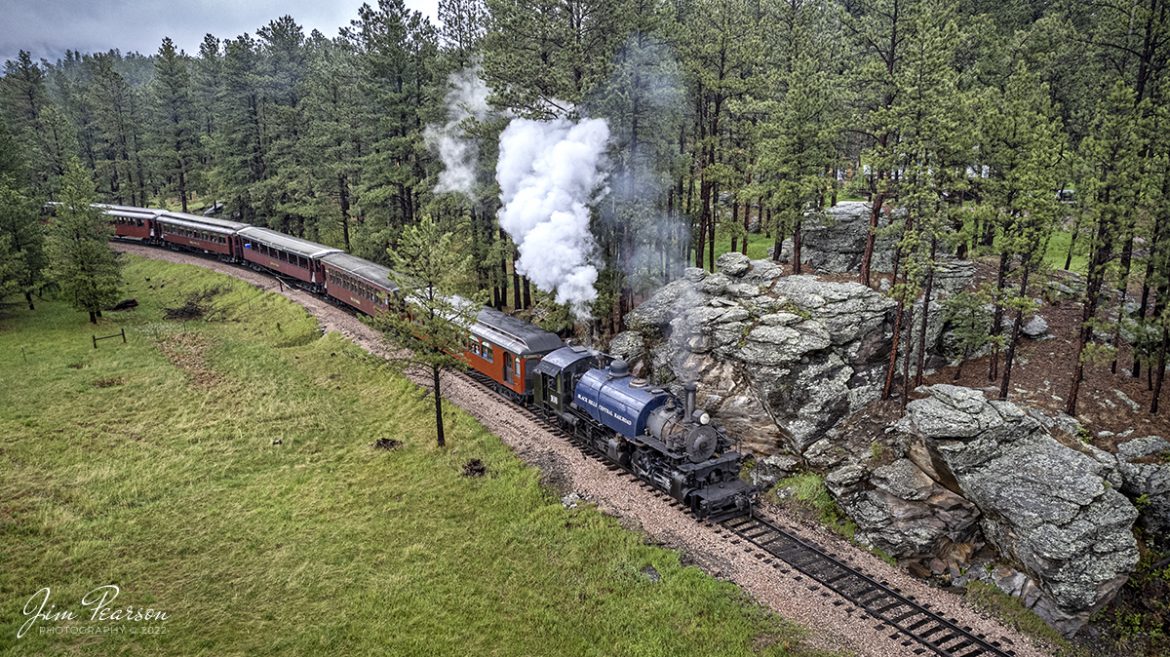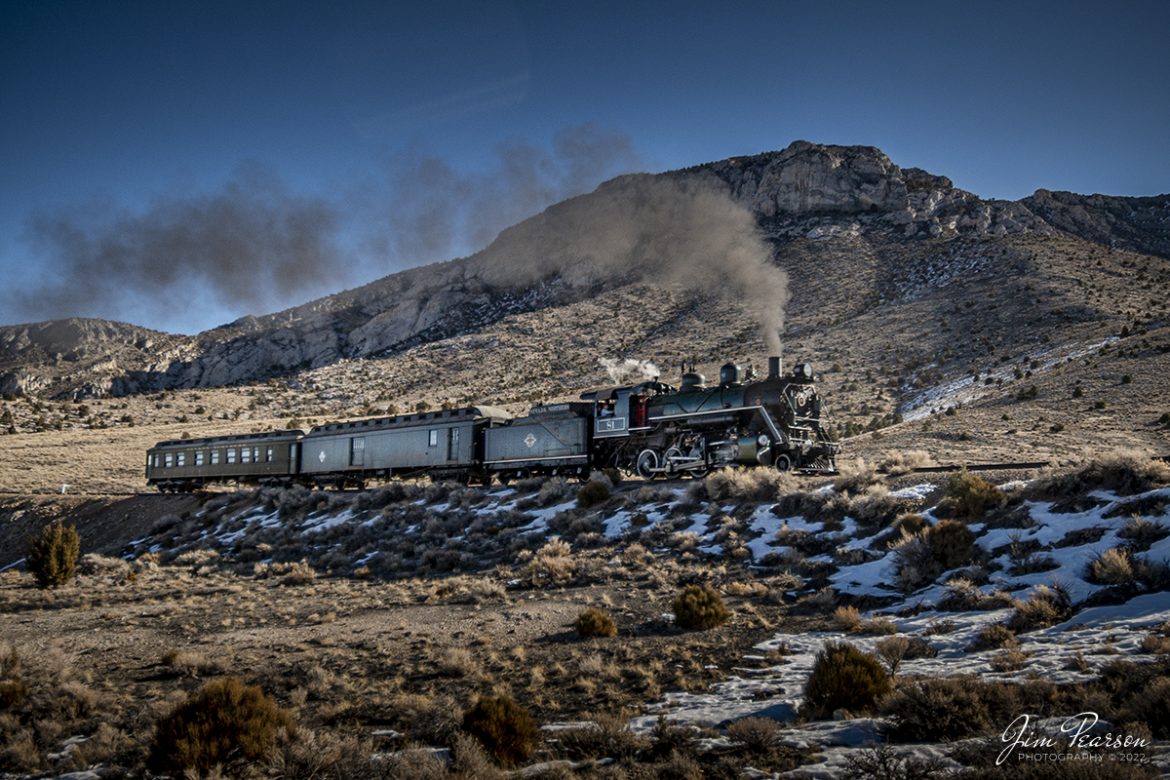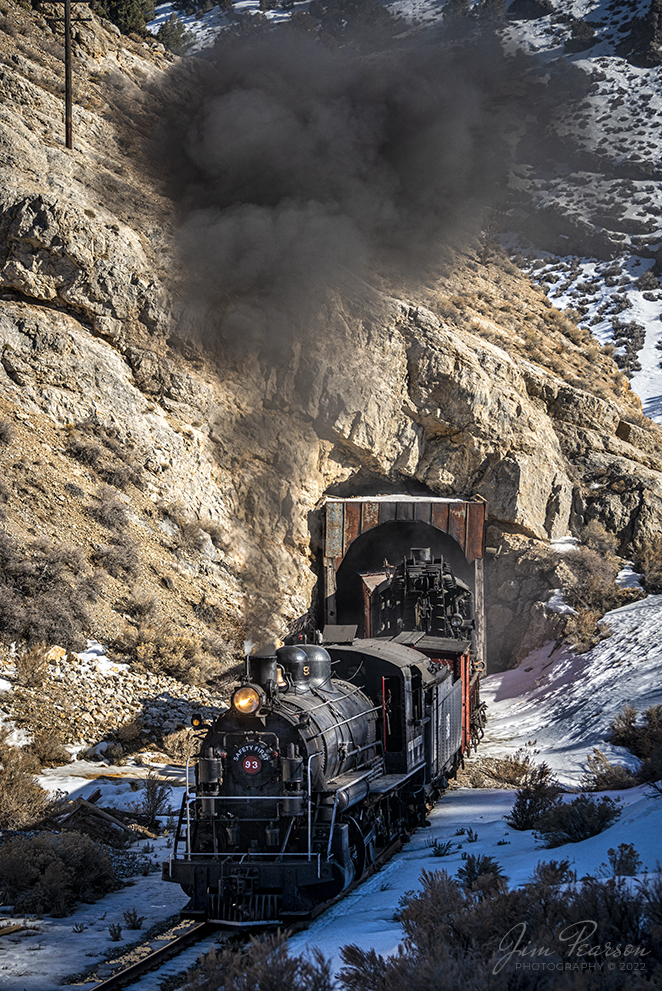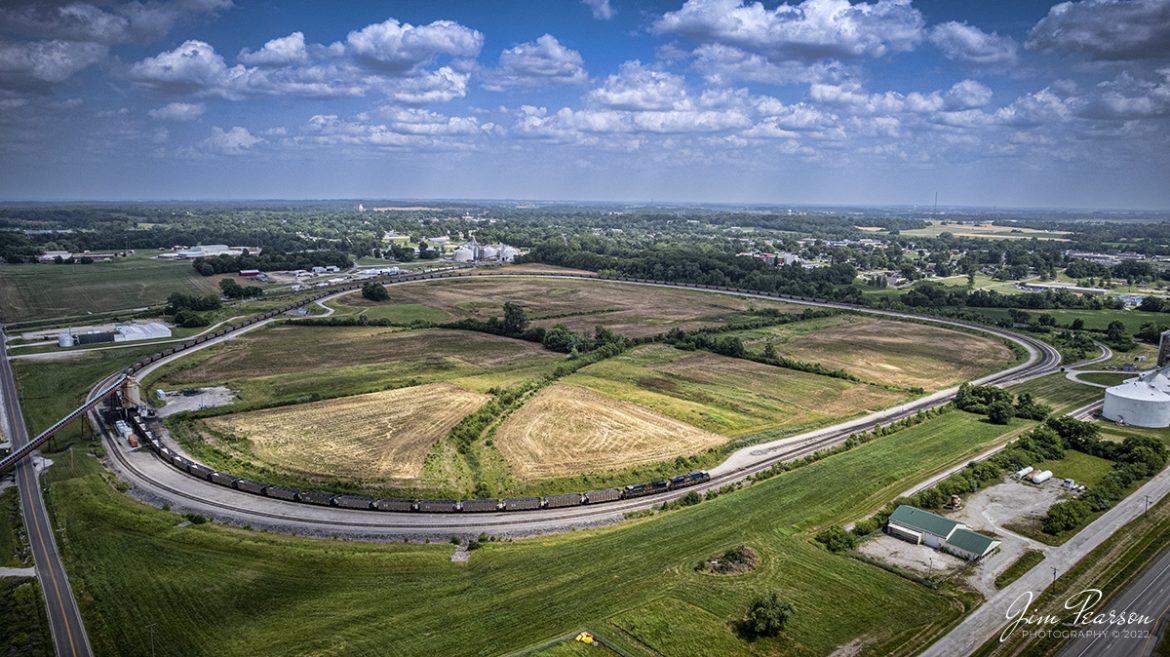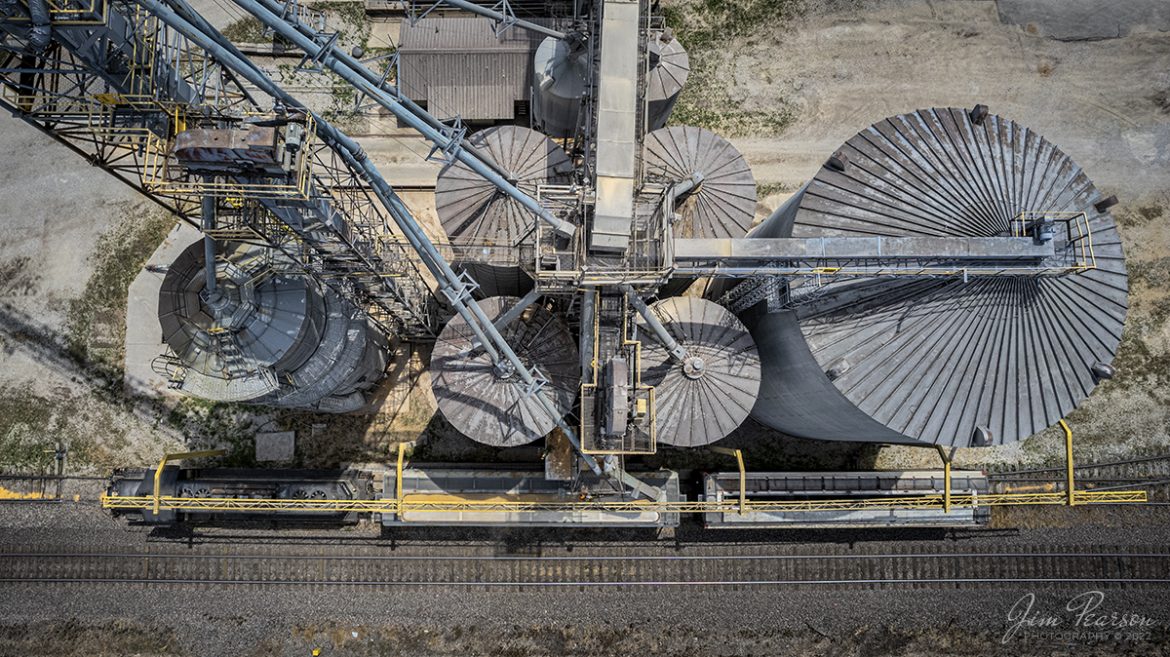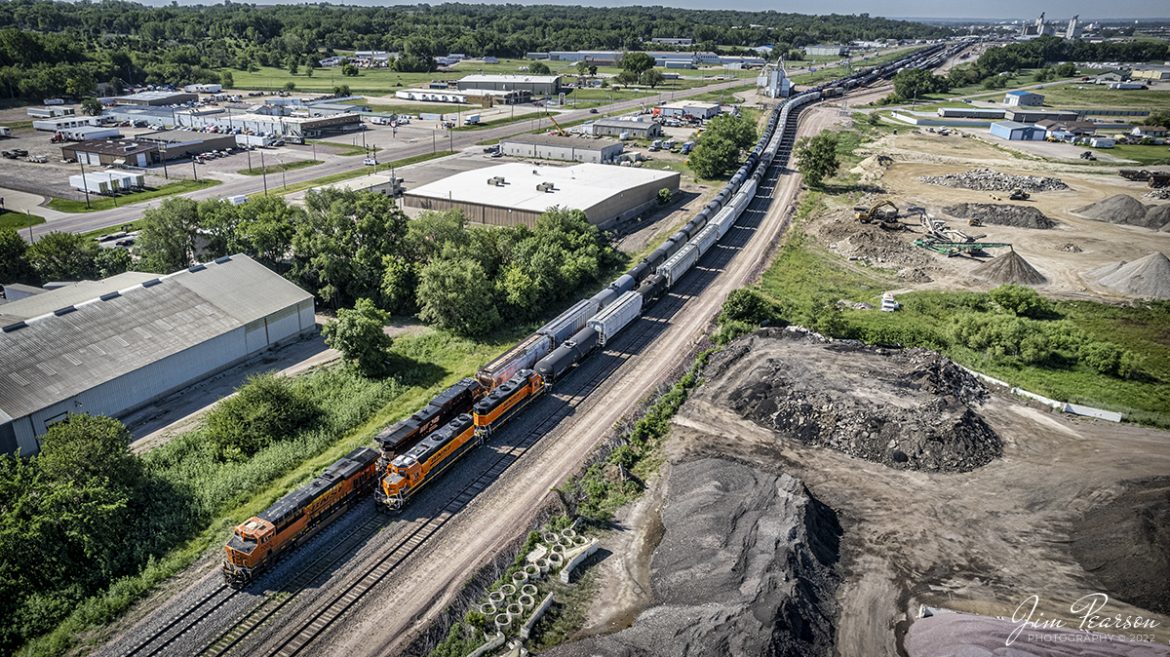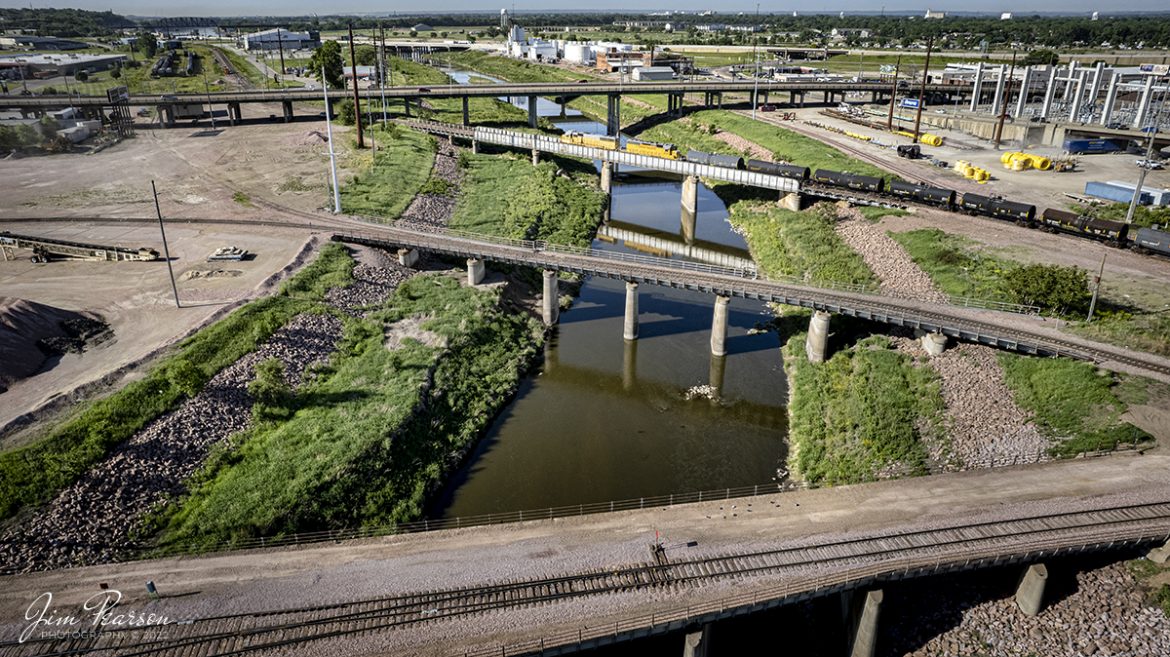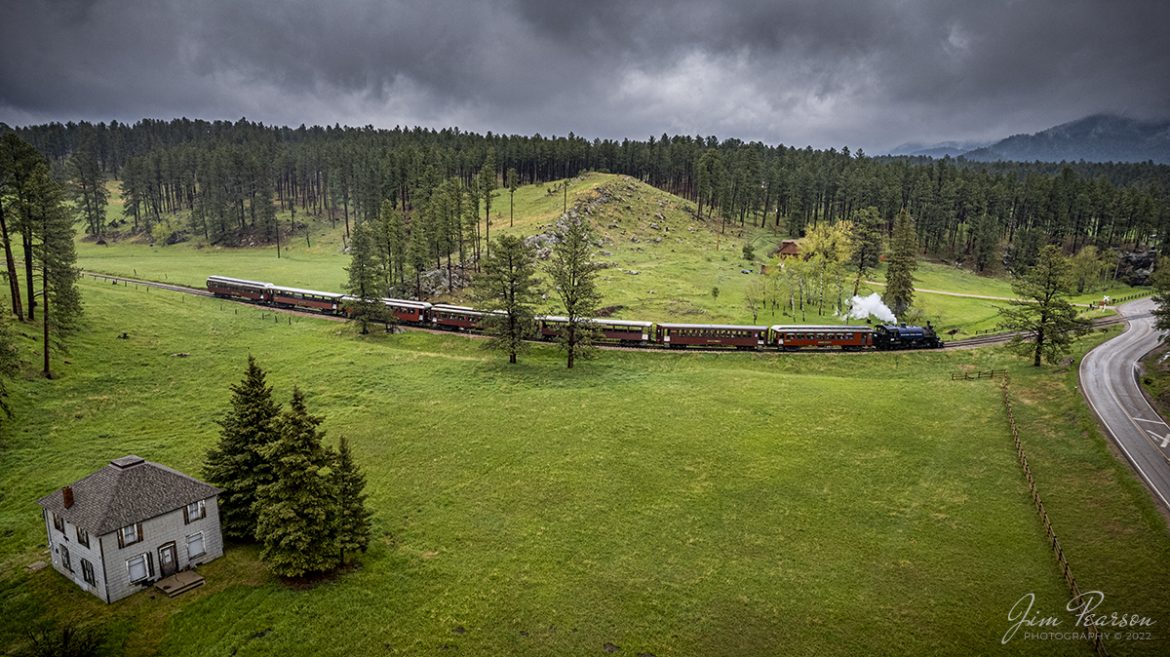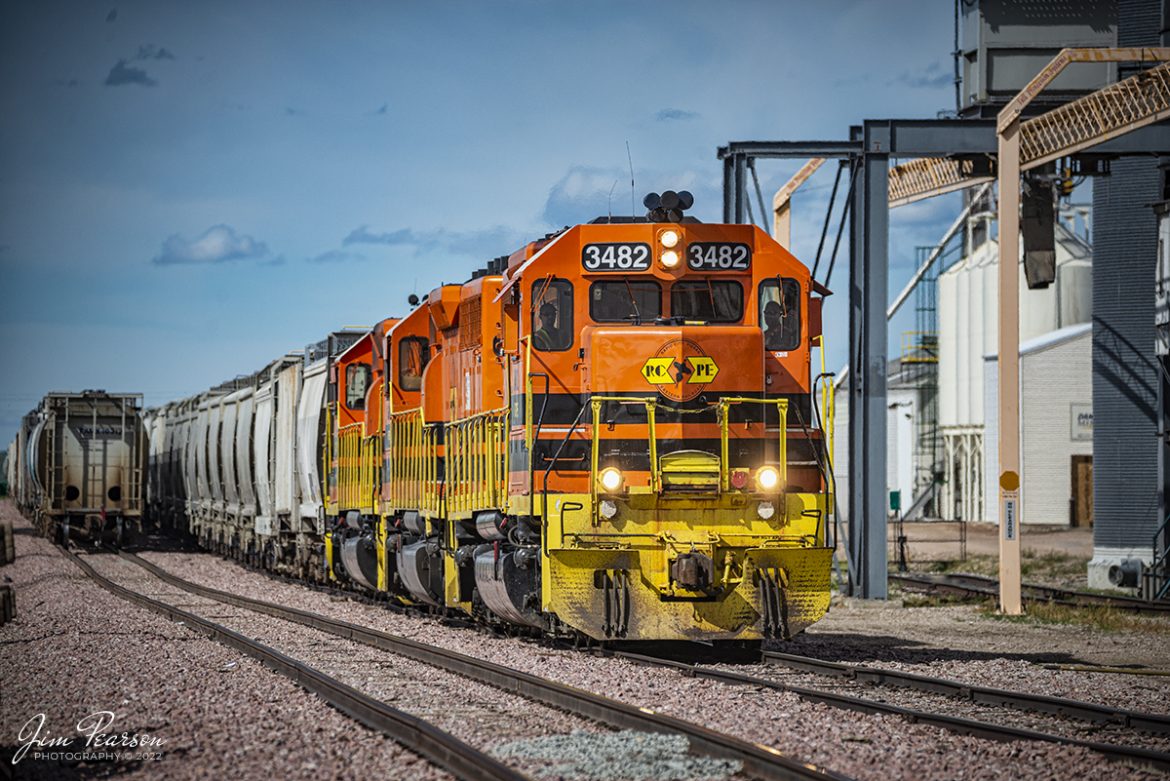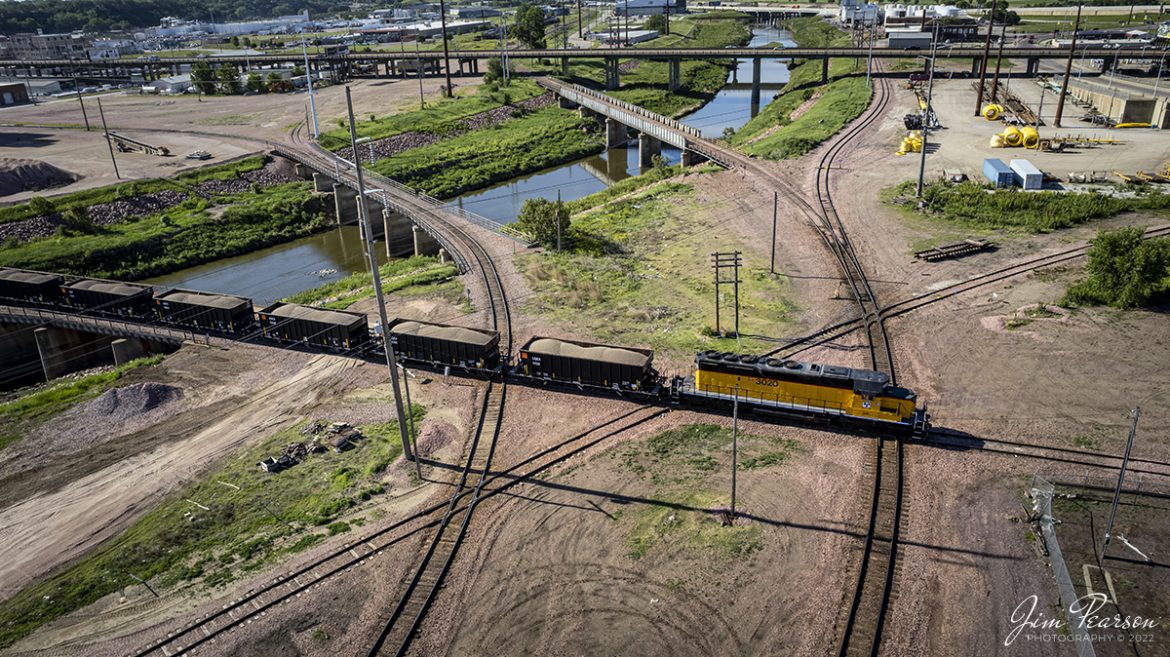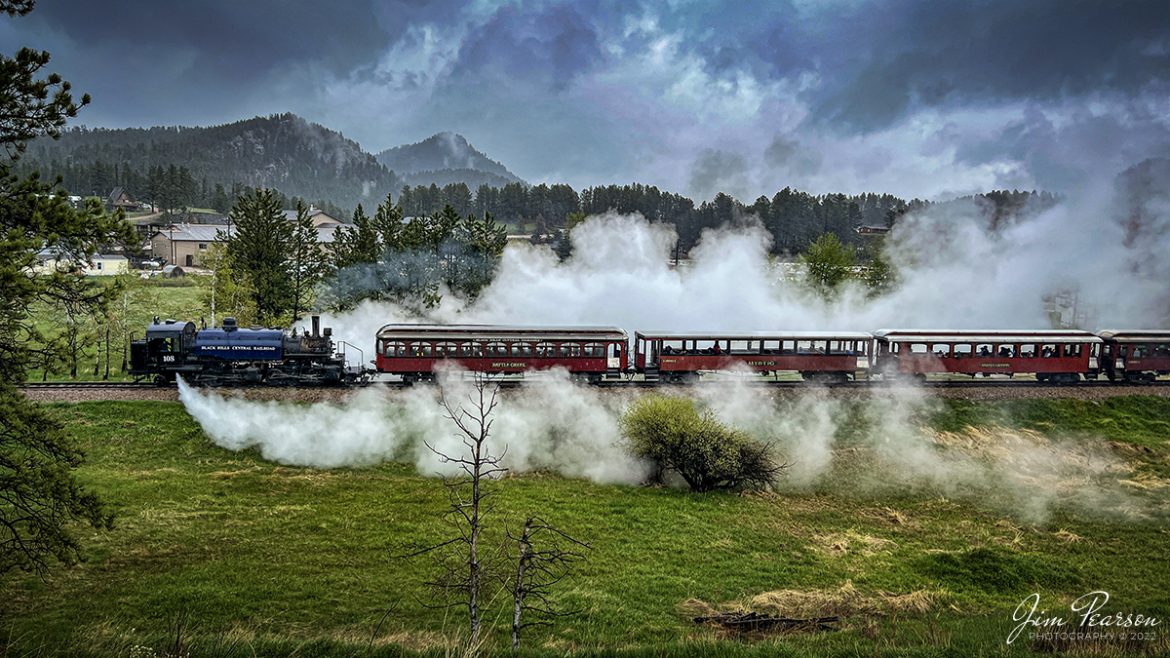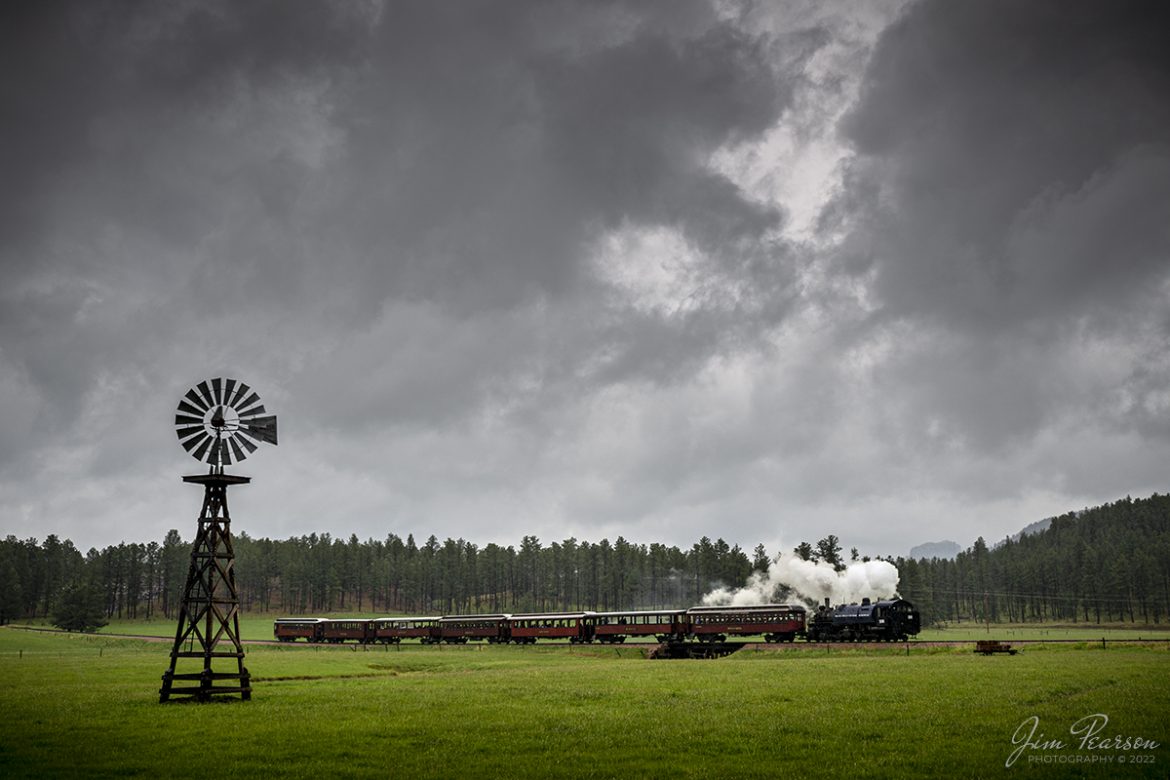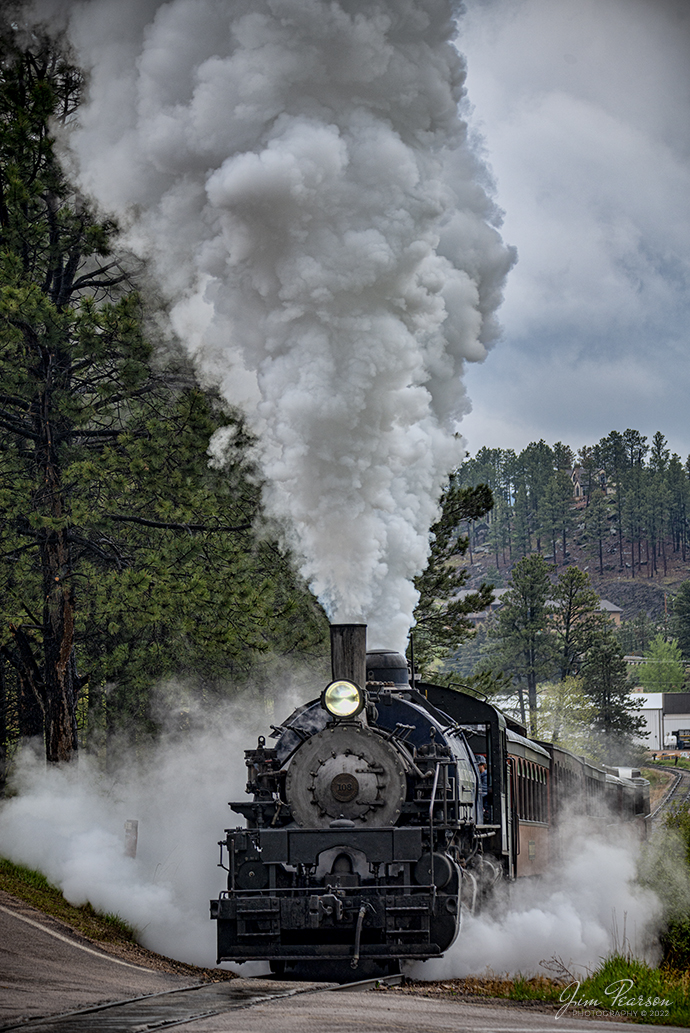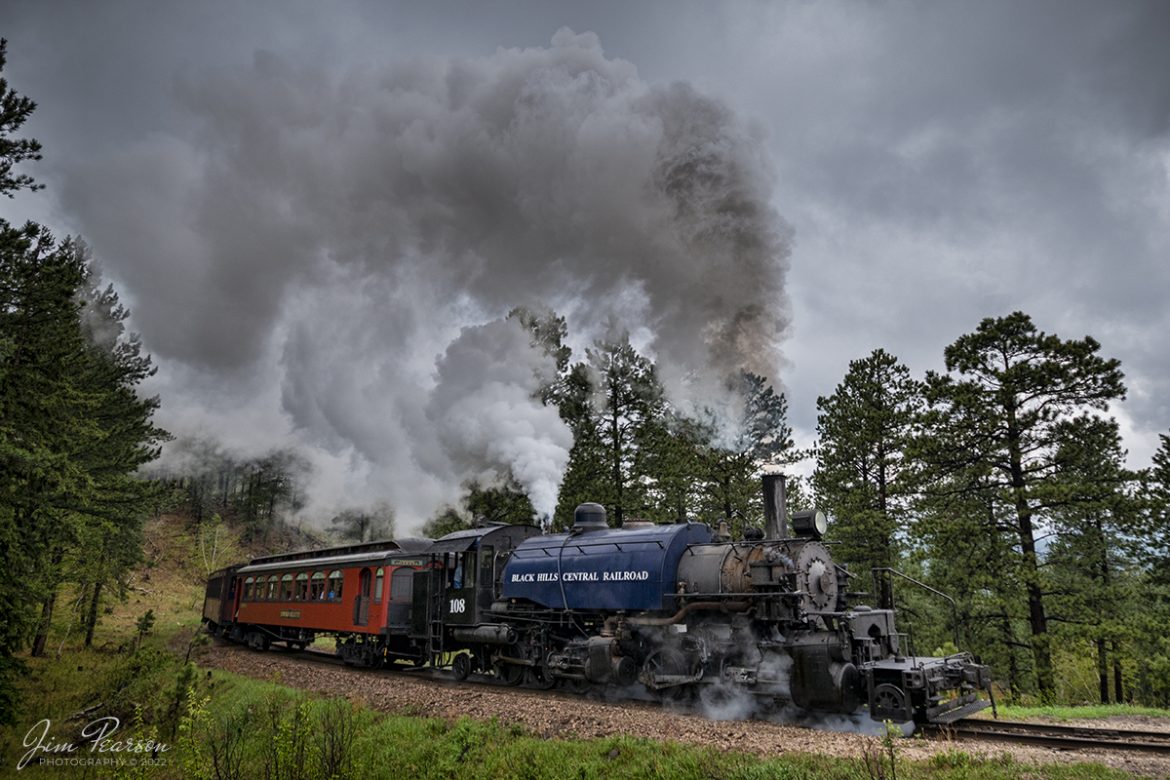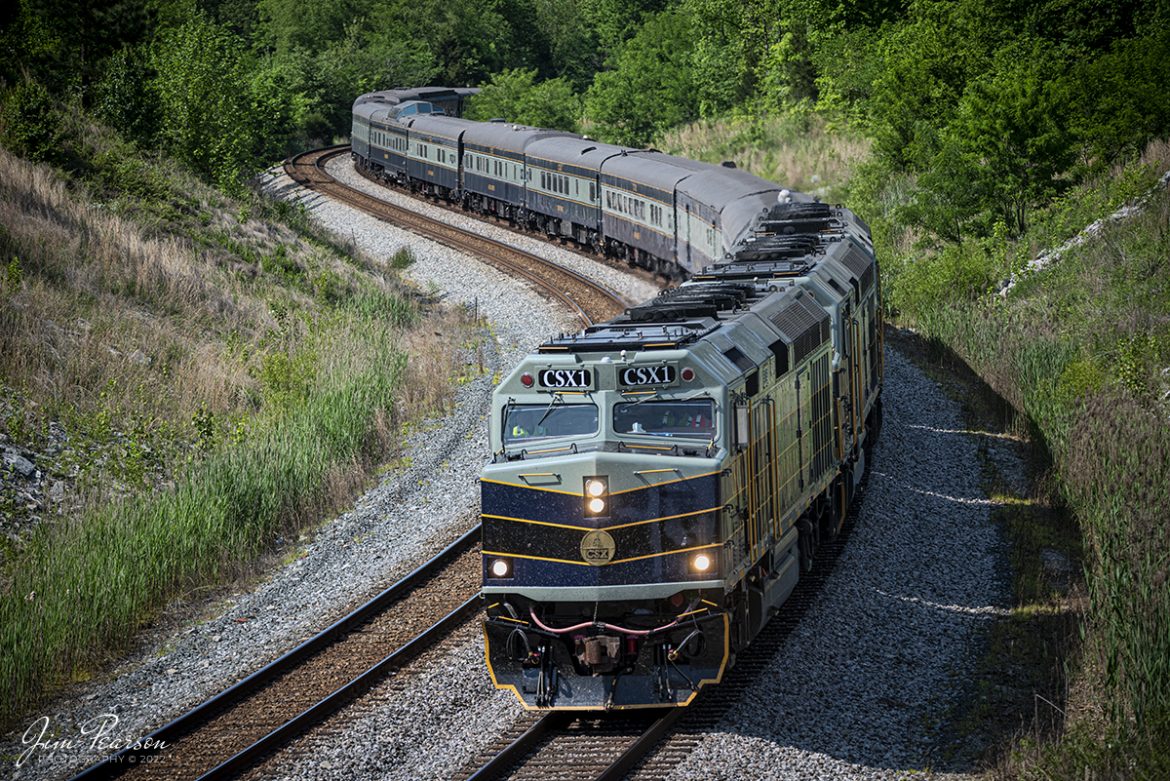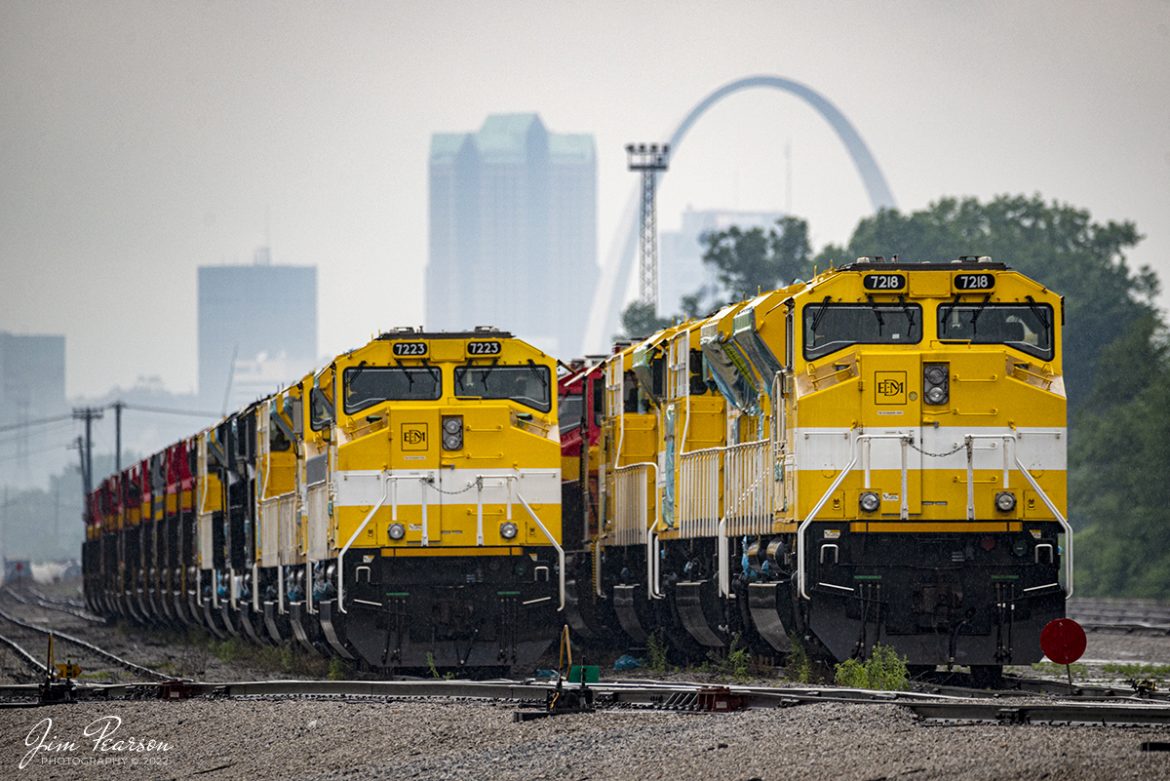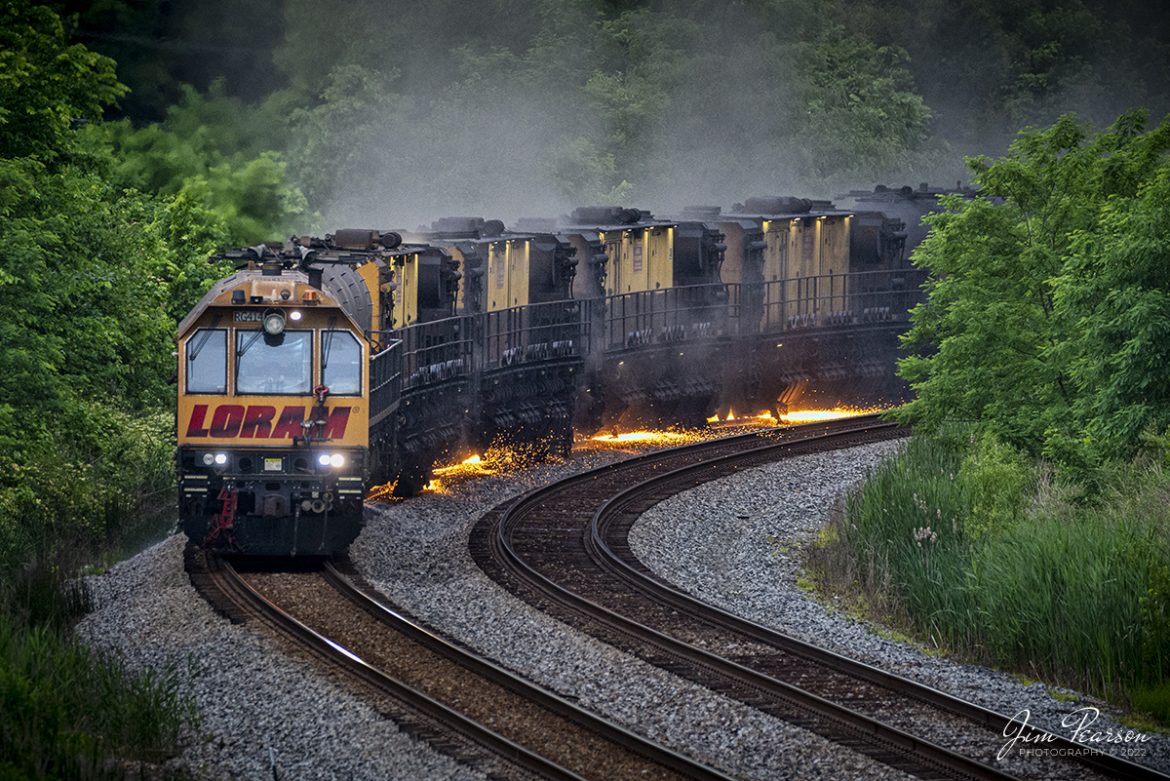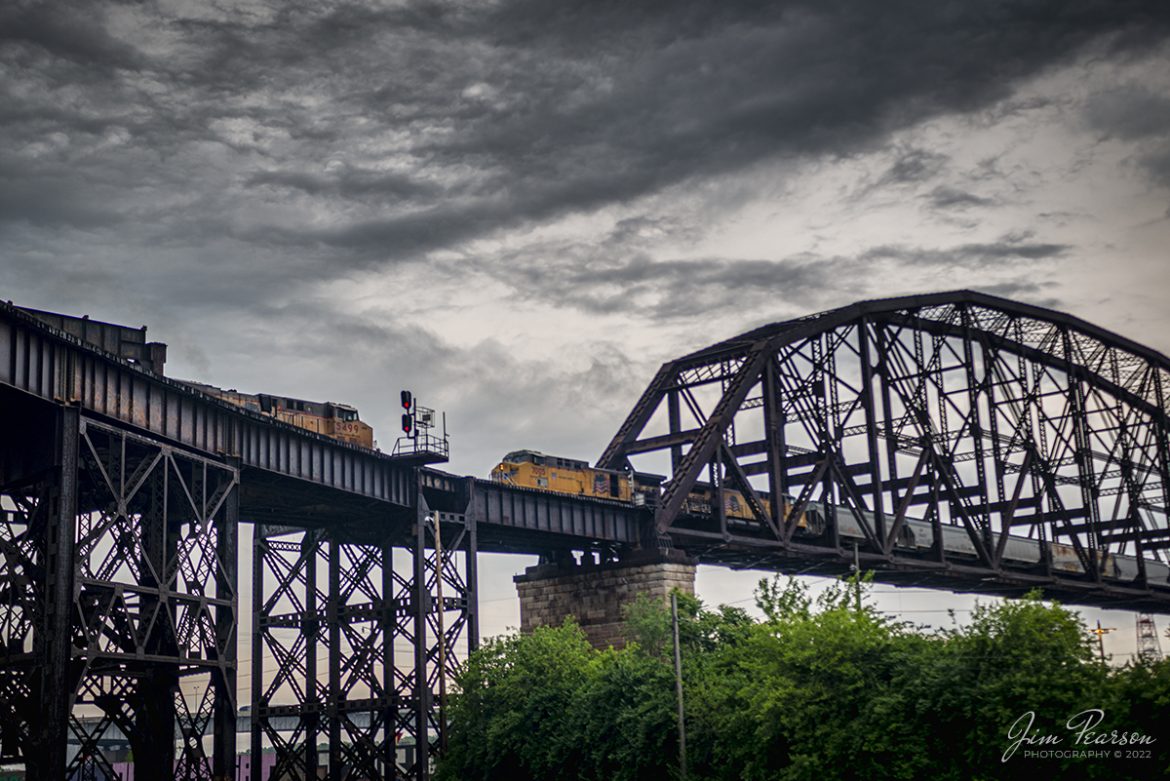I’ve posted a new selection of 5 new videos of live rail action in southern Indiana. Below is one of them and the others can be viewed on my YouTube Channel! I hope you enjoy them!
Black Hills Central Railway locomotive 108 heads through the countryside
The Black Hills Central Railway locomotive 108 heads through the countryside as it makes its first trip of the day in stormy, wet weather through the Black Hills on its way to Keystone, South Dakota on my birthday, May 30th, 2022!
According to their website: Locomotive #108 joined its nearly identical twin, #110, at the beginning of the 2020 season following a four-year restoration. It is a 2-6-6-2T articulated tank engine that was built by the Baldwin Locomotives Works in 1926 for the Potlatch Lumber Company. It later made its way to Weyerhaeuser Timber Company and eventually to the Northwest Railway Museum in Snoqualmie, Washington.
The acquisition and subsequent restoration of locomotive #108 completed a more than 20-year goal of increasing passenger capacity which began with the restoration of #110 and the restoration of multiple passenger cars. Both large Mallet locomotives (pronounced Malley) can pull a full train of seven authentically restored passenger cars, up from the four cars utilized prior to their addition to the roster.
Tech Info: DJI Mavic Air 2S Drone, RAW, 22mm, f/2.8, 1/320, ISO 200.
Nevada Northern Railway steam locomotive #81 pulls a passenger train through Steptoe Valle, Ely, Nevada
Nevada Northern Railway steam locomotive #81 pulls a passenger train through Steptoe Valley as it heads toward Ely, Nevada during the museums Winter Photo Charter event with engineer Dale Olson at the controls on the morning of February 13th, 2022.
According to Wikipedia: The Nevada Northern Railway Museum is a railroad museum and heritage railroad located in Ely, Nevada and operated by a historic foundation dedicated to the preservation of the Nevada Northern Railway.
The museum is situated at the East Ely Yards, which are part of the Nevada Northern Railway. The site is listed on the United States National Register of Historic Places as the Nevada Northern Railway East Ely Yards and Shops and is also known as the “Nevada Northern Railway Complex”. The rail yards were designated a National Historic Landmark District on September 27, 2006. The site was cited as one of the best-preserved early 20th-century railroad yards in the nation, and a key component in the growth of the region’s copper mining industry. Developed in the first decade of the 20th century, it served passengers and freight until 1983, when the Kennecott Copper Company, its then-owner, donated the yard to a local non-profit for preservation. The property came complete with all the company records of the Nevada Northern from its inception.
Engine #81 is a “Consolidation” type (2-8-0) steam locomotive that was built for the Nevada Northern in 1917 by the Baldwin Locomotive Works in Philadelphia, PA, at a cost of $23,700. It was built for Mixed service to haul both freight and passenger trains on the Nevada Northern railway.
Tech Info: Nikon D800, RAW, Nikon 10-24 @ 10mm, f/3.5, 1/2000, ISO 125.
Nevada Northern Railway steam locomotive #93 pulls out of tunnel one in Robinson Canyon, Ely, Nevada
Nevada Northern Railway steam locomotive #93 pulls out of tunnel one as it heads southbound through Robinson Canyon with a work train from Ely, Nevada during the final day of their 3-day Winter Photography Charter on February 13th, 2022. The piece of equipment just exiting the tunnel is the railroads operational steam crane.
Locomotive #93 is a 2-8-0 that was built by the American Locomotive Company in January of 1909 at a cost of $17,610. It was the last steam locomotive to retire from original revenue service on the Nevada Northern Railway in 1961 and was restored to service in 1993.
According to Wikipedia: The Nevada Northern Railway Museum is a railroad museum and heritage railroad located in Ely, Nevada and operated by a historic foundation dedicated to the preservation of the Nevada Northern Railway.
The museum is situated at the East Ely Yards, which are part of the Nevada Northern Railway. The site is listed on the United States National Register of Historic Places as the Nevada Northern Railway East Ely Yards and Shops and is also known as the Nevada Northern Railway Complex. The rail yards were designated a National Historic Landmark District on September 27, 2006. The site was cited as one of the best-preserved early 20th-century railroad yards in the nation, and a key component in the growth of the region’s copper mining industry. Developed in the first decade of the 20th century, it served passengers and freight until 1983, when the Kennecott Copper Company, its then-owner, donated the yard to a local non-profit for preservation. The property came complete with all the company records of the Nevada Northern from its inception.
Tech Info: Nikon D800, RAW, Nikon 70-300mm @ 90mm, f/4.5, 1/2000, ISO 400.
CSX E305 with CSXT 989 and 277 leading loads coal at Princeton, Indiana
CSX E305 with CSXT 989 and 277 leading, pulls around the Alliance Coal Loop at Princeton, Indiana on June 16th, 2022, in preparation for loading its train with coal on the CSX CE&D subdivision.
Tech Info: DJI Mavic Air 2S Drone, Altitude 270ft, RAW, 22mm, f/2.8, 1/2500, ISO 110.
Torpedo boat Geep FLSX 71 loads grain cars at Lyle Station, Indiana
Torpedo boat Geep FLSX 71 loads grain cars in this top-down view at Consolidated Grain and Barge, just west of County Road 475, at Lyles Station, Indiana at their elevator on June 16th, 2022. I understand that FLSX is Great Miami, Inc., and the locomotive is ex-CERA/CIND 1751, ex-MKT 120, nee-MKT 1761.
Tech Info: DJI Mavic Air 2S Drone, Altitude 270ft, RAW, 22mm, f/2.8, 1/2000, ISO 100.
BNSF 2557 and 2604 work the BNSF yard on the BNSF Marshall Subdivision at Sioux City, Iowa
BNSF 2557 and 2604 work the BNSF yard on the BNSF Marshall Subdivision at Sioux City, Iowa on the morning of June 3rd, 2022, a line of shadows leads back to the city in the distance.
According to the Sioux City History Website: When Sioux City first began to grow, most people arrived by either steamboat or stagecoach. In the eastern United States, railroads were being built to connect all major cities. The first railroad to develop in Iowa was in 1865, along the Mississippi. However, plans were soon developed to expand the system to all major Iowa cities.
Sioux City developers knew that if the town wanted to become a major city, it would need to be one of the first to have railroad access. Not only did railroads move people, but they also moved materials and manufactured goods.
In the fall of 1866, a large crowd of local businessmen, bankers, and speculators met with a gentleman named W.W. Walker. He was a representative of John Blair, a wealthy eastern railroad developer. Mr. Blair was planning on building the Sioux City and Pacific Railroad. This railroad would connect the city with the main line which ran through Missouri Valley. This would give the city connections all the way to Chicago and back east. All the city and county had to do was provide free land for the tracks and for the depot. The county agreed to donate the land in February of 1867. The deal was struck.
Tech Info: DJI Mavic Air 2S Drone, RAW, 22mm, f/2.8, 1/1500, ISO 120.
Union Pacific 2116 and 1825 lead a mixed freight southbound across the Floyd River at Sioux City, IA
Union Pacific 2116 and 1825 lead a mixed freight southbound across the Floyd River on the Worthington Subdivision amid a maze of bridges at Sioux City, Iowa on June 3rd, 2022, on a beautiful Spring Day.
According to the Sioux City History Website: When Sioux City first began to grow, most people arrived by either steamboat or stagecoach. In the eastern United States, railroads were being built to connect all major cities. The first railroad to develop in Iowa was in 1865, along the Mississippi. However, plans were soon developed to expand the system to all major Iowa cities.
Sioux City developers knew that if the town wanted to become a major city, it would need to be one of the first to have railroad access. Not only did railroads move people, but they also moved materials and manufactured goods.
In the fall of 1866, a large crowd of local businessmen, bankers, and speculators met with a gentleman named W.W. Walker. He was a representative of John Blair, a wealthy eastern railroad developer. Mr. Blair was planning on building the Sioux City and Pacific Railroad. This railroad would connect the city with the main line which ran through Missouri Valley. This would give the city connections all the way to Chicago and back east. All the city and county had to do was provide free land for the tracks and for the depot. The county agreed to donate the land in February of 1867. The deal was struck.
Tech Info: DJI Mavic Air 2S Drone, RAW, 22mm, f/2.8, 1/1250, ISO 120.
The 1880 Train, Black Hills Central Railroad locomotive heads through the Black Hills on the way to Keystone, SD
The 1880 Train, Black Hills Central Railroad locomotive crew on 108 blows for a crossing as they head through the Black Hills on the way to Keystone, SD on May 30th, 2022, under stormy skies.
According to their website: Locomotive #108 joined its nearly identical twin, #110, at the beginning of the 2020 season following a four-year restoration. It is a 2-6-6-2T articulated tank engine that was built by the Baldwin Locomotives Works in 1926 for the Potlatch Lumber Company. It later made its way to Weyerhaeuser Timber Company and eventually to the Northwest Railway Museum in Snoqualmie, Washington.
The acquisition and subsequent restoration of locomotive #108 completed a more than 20-year goal of increasing passenger capacity which began with the restoration of #110 and the restoration of multiple passenger cars. Both large Mallet locomotives (pronounced Malley) can pull a full train of seven authentically restored passenger cars, up from the four cars utilized prior to their addition to the roster.
Tech Info: DJI Mavic Air 2S Drone, RAW, 22mm, f/2.8, 1/500, ISO 110.
Rapid City, Pierre and Eastern Railroad3482 at Wall, South Dakota
Rapid City, Pierre and Eastern Railroad (RCPE) 3482 leads a train westbound through downtown Wall, South Dakota on May 29th, 2022, as it passes its eastbound counterpoint at Dakota Mill and Grain.
According to Wikipedia: Rapid City, Pierre and Eastern Railroad (reporting mark RCPE) is a Class II railroad operating across South Dakota and southern Minnesota in the northern plains of the United States. Portions of the railroad also extend into Wyoming and Nebraska. It is owned and operated by Genesee & Wyoming.
The Genesee & Wyoming, a holding company of mostly shortline railroads, formed the Rapid City, Pierre and Eastern to acquire the western end of the former Dakota, Minnesota and Eastern Railroad (DM&E) rail line from the Canadian Pacific Railway (CPR). The acquisition was completed on May 30, 2014, for $210 million. Most of its employees came over from the DM&E.
Tech Info: Nikon D800, RAW, Sigma 150-600 @ 270mm, f/5.6, 1/2500, ISO 280.
D&I Railroad 3020 heads across the Floyd River at Sioux City, Iowa
D&I Railroad 3020 (also nicknamed the Dakota and Iowa Railroad) heads across the Floyd River amid a maze of diamonds at Sioux City, Iowa on the Aberdeen Subdivision on June 3rd, 2022, with a loaded train.
According to Wikipedia: The D&I Railroad (DAIR) (also nicknamed the Dakota and Iowa Railroad) is a Class III shortline railroad which is a wholly owned subsidiary of L. G. Everist, Inc. The line hauls ethanol, dried distillers grains (DDG), corn oil, plastic pellets, cement, sand, gravel, and Sioux Quartzite, which is mined from two large quarries in Dell Rapids.
The D&I has a trackage rights agreement with BNSF that allows it to travel on three BNSF subdivisions to deliver and sell products, as they must use BNSFs system to reach their southern half of their trackage. The D&I operates on both former Chicago, Milwaukee, St. Paul and Pacific Railroad and Chicago and Northwestern Railroad trackage, which were handed over to the state of South Dakota in 1980-1981 after the Milwaukee Roads bankruptcy and subsequent abandonment of unprofitable lines.
Tech Info: DJI Mavic Air 2S Drone, RAW, 22mm, f/2.8, 1/1000, ISO 100.
Black Hills Central Railroad locomotive crew on 108 performs a blow down at Hill City, SD
The 1880 Train, Black Hills Central Railroad locomotive crew on 108 performs a blow down on the engine as they arrive back at Hill City, SD on May 30th, 2022, under stormy skies.
A Blowdown, where the left and right blow down cocks, located at the lowest portion of the firebox sides (mud ring), are opened to blow out mineral sediments in the boiler water. Addition of various chemicals in the tender water is designed to keep the sediments (mud, etc.) from sticking to the internal steel components of the firebox/boiler. On a regular basis, those “settled” sediments need to blown out at safe locations on the railroad. Thus, the locomotives are being “blown down”.
According to their website: Locomotive #108 joined its nearly identical twin, #110, at the beginning of the 2020 season following a four-year restoration. It is a 2-6-6-2T articulated tank engine that was built by the Baldwin Locomotives Works in 1926 for the Potlatch Lumber Company. It later made its way to Weyerhaeuser Timber Company and eventually to the Northwest Railway Museum in Snoqualmie, Washington.
The acquisition and subsequent restoration of locomotive #108 completed a more than 20-year goal of increasing passenger capacity which began with the restoration of #110 and the restoration of multiple passenger cars. Both large Mallet locomotives (pronounced Malley) can pull a full train of seven authentically restored passenger cars, up from the four cars utilized prior to their addition to the roster.
Tech Info: iPhone 13 Pro Max, 5.7mm, f/1.5, 1/1147, ISO 50.
The Black Hills Central Railroad locomotive 108 passes an old windmill
The Black Hills Central Railroad locomotive 108 passes an old windmill in a flat section of the Black Hills as it pulls its train from Keystone to Hill City, SD on May 30th, 2022 under stormy skies.
According to their website: Locomotive #108 joined its nearly identical twin, #110, at the beginning of the 2020 season following a four-year restoration. It is a 2-6-6-2T articulated tank engine that was built by the Baldwin Locomotives Works in 1926 for the Potlatch Lumber Company. It later made its way to Weyerhaeuser Timber Company and eventually to the Northwest Railway Museum in Snoqualmie, Washington.
The acquisition and subsequent restoration of locomotive #108 completed a more than 20-year goal of increasing passenger capacity which began with the restoration of #110 and the restoration of multiple passenger cars. Both large Mallet locomotives (pronounced Malley) can pull a full train of seven authentically restored passenger cars, up from the four cars utilized prior to their addition to the roster.
Tech Info: Nikon D800, RAW, Sigma 24-70mm @ 24mm, f/4.5, 1/400, ISO 100.
Black Hills Central Railroad locomotive 108 climbs the grade out of Hill City, SD
The Black Hills Central Railroad locomotive 108 climbs the grade as it approaches the Hill City – Keystone Road Crossing, as it makes its first trip of the day to Keystone, South Dakota from Hill City on May 30th, 2022!
According to their website: Locomotive #108 joined its nearly identical twin, #110, at the beginning of the 2020 season following a four-year restoration. It is a 2-6-6-2T articulated tank engine that was built by the Baldwin Locomotives Works in 1926 for the Potlatch Lumber Company. It later made its way to Weyerhaeuser Timber Company and eventually to the Northwest Railway Museum in Snoqualmie, Washington.
The acquisition and subsequent restoration of locomotive #108 completed a more than 20-year goal of increasing passenger capacity which began with the restoration of #110 and the restoration of multiple passenger cars. Both large Mallet locomotives (pronounced Malley) can pull a full train of seven authentically restored passenger cars, up from the four cars utilized prior to their addition to the roster.
Tech Info: Nikon D800, RAW, Sigma 150-600mm @ 150mm, f/5, 1/400, ISO 320.
Black Hills Central Railway locomotive 108 heads through the countryside from Hill City, SD
The Black Hills Central Railway locomotive 108 heads through the countryside as it makes its first trip of the day in stormy, wet weather of the forest to Keystone, South Dakota on my birthday, May 30th, 2022! I for one can’t recall a better way to spend the day then chasing a steam locomotive and they later in the day riding it with family! Despite the wet and rainy weather, it was a great day, and I even got the drone up a few times! A big shout out to Cory Jakeway for all the help on finding my way around on the railroad and railfanning with me!
According to their website: Locomotive #108 joined its nearly identical twin, #110, at the beginning of the 2020 season following a four-year restoration. It is a 2-6-6-2T articulated tank engine that was built by the Baldwin Locomotives Works in 1926 for the Potlatch Lumber Company. It later made its way to Weyerhaeuser Timber Company and eventually to the Northwest Railway Museum in Snoqualmie, Washington.
The acquisition and subsequent restoration of locomotive #108 completed a more than 20-year goal of increasing passenger capacity which began with the restoration of #110 and the restoration of multiple passenger cars. Both large Mallet locomotives (pronounced Malley) can pull a full train of seven authentically restored passenger cars, up from the four cars utilized prior to their addition to the roster.
Keep an eye out over the next few weeks for images from this 3,600-mile trip!
Tech Info: Nikon D800, RAW, Nikon 10-24mm @ 13mm, f/3.8, 1/400, ISO 250.
CSX P001-09 Presidential Office Car passenger train southbound at Nortonville, KY
May 12, 2022 – CSX P001-09 Presidential Office Car passenger train heads through the S curve at Nortonville, Kentucky, with CSXT 1, 2 and 3 leading the way, southbound on the Henderson Subdivision.
CSX Transportation has repainted 3 of its executive fleet F40PH locomotives in a paint scheme inspired by predecessor Baltimore & Ohio and a fleet of cars to finish out the train set. The city of Baltimore chartered the railroad on Feb. 28, 1827, to build west to a suitable point on the Ohio River. Ground was broken on July 4, 1828, at Carrollton, Md. By 1929 the railroad operated 5,658 miles of track and had 2,364 locomotives. In the 1970s the B&O became part of Chessie System and in the 1980s it became part of CSX.
Tech Info: Nikon D800, RAW, Sigma 150-600 @ 220mm, f/5.3, 1/2000, ISO 560.
Progress Rail EMDs 7223 and 7218 head up strings of locomotives at East St. Louis, IL
Progress Rail EMDs 7223 and 7218 head up strings of locomotives that are stored on the tracks at just outside the KCS East St. Louis, IL yard as downtown St. Louis and the Arch looms in the background a misty rainy day on May 21st, 2022.
According to Wikipedia: Progress Rail Services Corporation (reporting mark PRLX), a wholly owned subsidiary of Caterpillar since 2006, is a supplier of railroad and transit system products and services headquartered in Albertville, Alabama. Founded as a recycling company in 1982, Progress Rail has increased the number of its product and service offerings over time to become one of the largest integrated and diversified suppliers of railroad and transit system products and services in North America. Progress Rail markets products and services worldwide and maintains 110 facilities in the United States, 34 in Mexico, four in Canada, two in Brazil, five in UK, one in Italy, and one in Germany.
Tech Info: Nikon D800, RAW, Sigma 150-600 @ 500mm, f/6, 1/500, ISO 500.
LIVE – LORAM Railgrinder working it’s way south at Nortonville, Kentucky on May 23rd, 2022.
Loram Railgrinder southbound at Mortons Gap, KY on the CSX Henderson Subdivision
LORAM Railgrinder RG414 grinds through a curve at Nortonville, Ky on the CSX Henderson Subdivision
LORAM Railgrinder RG414 grinds through a curve as it makes its way south at Nortonville, Kentucky on the CSX Henderson Subdivision on May 23rd, 2022.
According to LORAMs Website: Rail grinding is the cornerstone of virtually every railroad maintenance program. It maximizes the life and value of rail assets through precision removal of fatigued metal, restoration of the rail head profile and removal of rail defects which are the optimization goals of an effective rail grinding program.
Tech Info: Nikon D800, RAW, Sigma 150-600 @ 390mm, f/6, 1/250, ISO 3600.
Union Pacific Railroad freights meet on the MacArthur Bridge at St. Louis, Missouri
Two Union Pacific Railroad freights meet on the MacArthur Bridge on the TRRA MacArthur Subdivision in downtown St. Louis, Missouri on May 21st, 2022, under stormy skies. I really wanted to fly my drone for this shot, but unfortunately this area was a FAA no fly zone for drones.
According to Wikipedia: The MacArthur Bridge is a truss bridge that connects St. Louis, Missouri and East St. Louis, Illinois over the Mississippi River. The bridge was initially called the “St. Louis Municipal Bridge” and known popularly as the “Free Bridge” due to the original lack of tolls. Tolls were added for auto traffic beginning in 1932. In 1942, the bridge was renamed for Douglas MacArthur.
Upon completion, the structure was the largest double-deck steel bridge in the world.
Tech Info: Nikon D800, RAW, Sigma 24-70 @ 40mm, f/3.5, 1/640, ISO 125.

